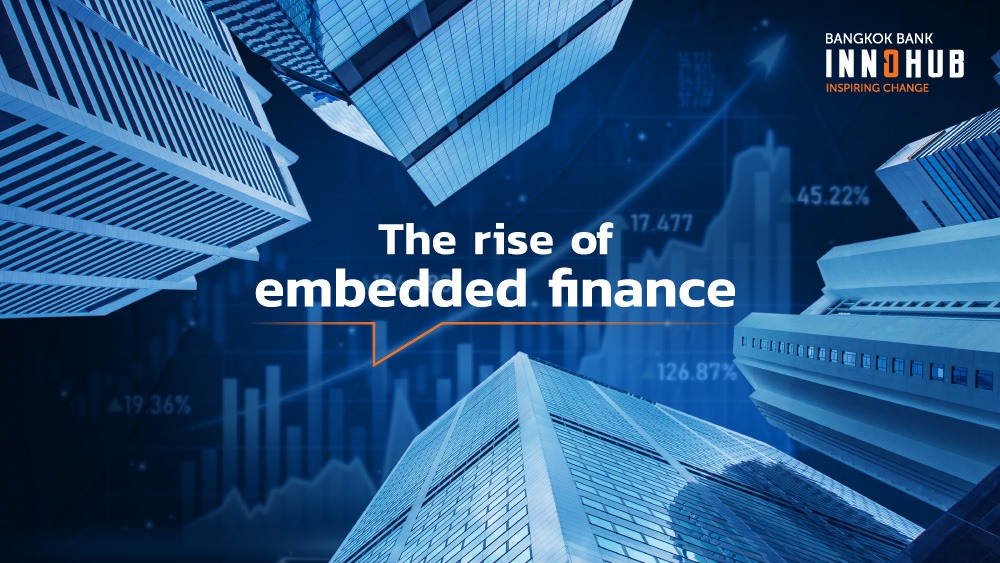The pandemic and its effects have forced businesses to accelerate their digitization strategies, with embedded finance at the forefront of this new trend. In fact, recent studies predict that embedded finance will have a global estimated market value of over $138 billion by 2026. Thailand’s own embedded finance market is expected to reach $1.576 million in 2022.
To understand the hype, it is important to examine the ways in which seamlessly integrating financial services will affect the end consumer and drive business. Here we explore why embedded services such as buy now, pay later (BNPL) are on the rise, and what some future applications of this approach may be.
What is embedded finance
At its core, “embedded finance” simply means the use of financial tools or services, such as lending, payment processing, or insurance by a non-financial provider, that is integrated into a business process. The availability of these tools is made possible through API’s (application programming interfaces), which allow different types of software to connect with each other.
If done well, most end consumers will not even realize they have used embedded finance or an outsourced third party to complete a transaction. In the past, users were often redirected to external vendors to complete financial transactions when buying online, because offering financial services creates significant problems for companies. At a minimum, such services introduce risk compliance and regulatory issues, as well as the need to develop payment technology and related software, which can be time-consuming and expensive.
Banking as a Service (BaaS) lets companies provide better, more comprehensive service while keeping customers within their digital ecosystems. The future will see more integration and well-designed API’s, of this sort, allowing traditional banks to remain involved but become less visible, with e-transactions seeming as though they are kept between the consumer and vendor. This push towards efficiency and interoperability will massively reduce the resource burden of building new financial services, so that more time can be spent on pure innovation.
In essence, banking and financial tasks are no longer treated as separate from other activities. Consumers now expect to be able to complete their transactions within an app or company ecosystem without having to leave the site or deal directly with third-party vendors.
This development relies on FinTech, though the two are not the same. FinTech is a specialized set of technology tools used by financial institutions, allowing for subscription management, cryptocurrency investment, and data protection. In simple terms, embedded finance is what will make each sale easier for the customers. FinTech comprises the tools and software financial institutions that complete such transactions on the back end.
Benefits of embedded finance
Especially in Southeast Asia, where smartphone use is significantly higher than elsewhere and local populations show a clear openness to online shopping, the rise of embedded finance is already changing the way business is conducted at a basic level. The past decade has seen a digital transformation in Southeast Asia, and the region continues to be a global leader in the adoption of new digital technologies.
At the same time, however, Southeast Asian populations comparatively lack the level of formal education that some other regions enjoy, and many people are less connected with modern financial institutions. 6 out of 10 Southeast Asians are currently underbanked, and only 3 in 100 have a credit card. This sizable group of underserved consumers represents a market segment that traditional banks have simply been unable to reach, and embedded banking represents the best way to connect with this enormous customer base.
The main benefit of embedded finance is that it reduces consumer pain points such as needing to seek credit elsewhere. It is also more convenient and satisfying to complete a purchase within a company’s own digital ecosystem, resulting in greater brand loyalty. For businesses, the opportunity to connect with new sources of income can significantly increase market potential.
Such methods also increase the attractiveness of your product. Improving user experience through this one-stop shopping model can make your products more attractive, while also delivering valuable business insights and customer data. Embedded finance can help companies understand their consumers, spending habits, and needs, leading to better engagement and profitability.
Some current applications of embedded finance
One of the best examples of embedded finance can be found in ride-hailing apps such as Uber, Lyft or Grab. Rides can be booked and paid for within the app, with no need for users to worry about cash or other external forms of payment. Just book the service needed, and the transaction is handled through the system.
Similarly, installment payment services act as a form of money lending for large online stores such as Amazon and Shopify. They allow merchants to gain access to flexible payment options, outsourcing the financial side to a third party that will keep everything integrated.
Better integration also involves the use of FinTech as a service. For example, Akurateco is a Dutch white label cashier platform which allows merchants from almost any business niche to offer their customers multiple payment solutions with just one integration, creating new opportunities and streamlining the user experience.
The embedded finance market is growing rapidly. For companies wishing to digitize their business models, integrating embedded finance is a global trend that will increase for the foreseeable future and can elevate the user experience. Moving forward, every digital presence will need to integrate embedded finance to remain viable, as increasing the number of revenue channels can bring businesses closer to their customers, keeping payments within their own digital ecosystem.




